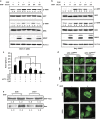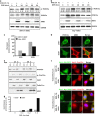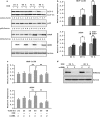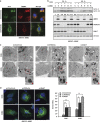ARHI (DIRAS3) induces autophagy in ovarian cancer cells by downregulating the epidermal growth factor receptor, inhibiting PI3K and Ras/MAP signaling and activating the FOXo3a-mediated induction of Rab7
- PMID: 24769729
- PMCID: PMC4085535
- DOI: 10.1038/cdd.2014.48
ARHI (DIRAS3) induces autophagy in ovarian cancer cells by downregulating the epidermal growth factor receptor, inhibiting PI3K and Ras/MAP signaling and activating the FOXo3a-mediated induction of Rab7
Abstract
The process of autophagy has been described in detail at the molecular level in normal cells, but less is known of its regulation in cancer cells. Aplasia Ras homolog member I (ARHI; DIRAS3) is an imprinted tumor suppressor gene that is downregulated in multiple malignancies including ovarian cancer. Re-expression of ARHI slows proliferation, inhibits motility, induces autophagy and produces tumor dormancy. Our previous studies have implicated autophagy in the survival of dormant ovarian cancer cells and have shown that ARHI is required for autophagy induced by starvation or rapamycin treatment. Re-expression of ARHI in ovarian cancer cells blocks signaling through the PI3K and Ras/MAP pathways, which, in turn, downregulates mTOR and initiates autophagy. Here we show that ARHI is required for autophagy-meditated cancer cell arrest and ARHI inhibits signaling through PI3K/AKT and Ras/MAP by enhancing internalization and degradation of the epidermal growth factor receptor. ARHI-mediated downregulation of PI3K/AKT and Ras/ERK signaling also decreases phosphorylation of FOXo3a, which sequesters this transcription factor in the nucleus. Nuclear retention of FOXo3a induces ATG4 and MAP-LC3-I, required for maturation of autophagosomes, and also increases the expression of Rab7, required for fusion of autophagosomes with lysosomes. Following the knockdown of FOXo3a or Rab7, autophagolysosome formation was observed but was markedly inhibited, resulting in numerous enlarged autophagosomes. ARHI expression correlates with LC3 expression and FOXo3a nuclear localization in surgical specimens of ovarian cancer. Thus, ARHI contributes to the induction of autophagy through multiple mechanisms in ovarian cancer cells.
Figures








Similar articles
-
The tumor suppressor gene ARHI regulates autophagy and tumor dormancy in human ovarian cancer cells.J Clin Invest. 2008 Dec;118(12):3917-29. doi: 10.1172/JCI35512. Epub 2008 Nov 20. J Clin Invest. 2008. PMID: 19033662 Free PMC article.
-
The role of vascular endothelial growth factor, interleukin 8, and insulinlike growth factor in sustaining autophagic DIRAS3-induced dormant ovarian cancer xenografts.Cancer. 2019 Apr 15;125(8):1267-1280. doi: 10.1002/cncr.31935. Epub 2019 Jan 8. Cancer. 2019. PMID: 30620384 Free PMC article.
-
ARHI (DIRAS3)-mediated autophagy-associated cell death enhances chemosensitivity to cisplatin in ovarian cancer cell lines and xenografts.Cell Death Dis. 2015 Aug 6;6(8):e1836. doi: 10.1038/cddis.2015.208. Cell Death Dis. 2015. PMID: 26247722 Free PMC article.
-
DIRAS3: An Imprinted Tumor Suppressor Gene that Regulates RAS and PI3K-driven Cancer Growth, Motility, Autophagy, and Tumor Dormancy.Mol Cancer Ther. 2022 Jan;21(1):25-37. doi: 10.1158/1535-7163.MCT-21-0331. Epub 2021 Oct 19. Mol Cancer Ther. 2022. PMID: 34667114 Review.
-
Epigenetic regulation of ARHI in breast and ovarian cancer cells.Ann N Y Acad Sci. 2003 Mar;983:268-77. doi: 10.1111/j.1749-6632.2003.tb05981.x. Ann N Y Acad Sci. 2003. PMID: 12724231 Review.
Cited by
-
Autophagy, molecular chaperones, and unfolded protein response as promoters of tumor recurrence.Cancer Metastasis Rev. 2023 Mar;42(1):217-254. doi: 10.1007/s10555-023-10085-3. Epub 2023 Feb 1. Cancer Metastasis Rev. 2023. PMID: 36723697 Review.
-
FOXO3/Rab7-Mediated Lipophagy and Its Role in Zn-Induced Lipid Metabolism in Yellow Catfish (Pelteobagrus fulvidraco).Genes (Basel). 2024 Mar 4;15(3):334. doi: 10.3390/genes15030334. Genes (Basel). 2024. PMID: 38540393 Free PMC article.
-
The functional and pathologic relevance of autophagy proteases.J Clin Invest. 2015 Jan;125(1):33-41. doi: 10.1172/JCI73940. Epub 2015 Jan 2. J Clin Invest. 2015. PMID: 25654548 Free PMC article. Review.
-
The COPS3-FOXO3 positive feedback loop regulates autophagy to promote cisplatin resistance in osteosarcoma.Autophagy. 2023 Jun;19(6):1693-1710. doi: 10.1080/15548627.2022.2150003. Epub 2022 Nov 30. Autophagy. 2023. PMID: 36451342 Free PMC article.
-
DIRAS3 (ARHI) Blocks RAS/MAPK Signaling by Binding Directly to RAS and Disrupting RAS Clusters.Cell Rep. 2019 Dec 10;29(11):3448-3459.e6. doi: 10.1016/j.celrep.2019.11.045. Cell Rep. 2019. PMID: 31825828 Free PMC article.
References
-
- Melendez A, Levine B. Autophagy in C. elegans. WormBook. 2009;24:1–26. - PubMed
-
- Rosen DG, Wang L, Jain AN, Lu KH, Luo RZ, Yu Y, et al. Expression of the tumor suppressor gene ARHI in epithelial ovarian cancer is associated with increased expression of p21WAF1/CIP1 and prolonged progression-free survival. Clin Cancer Res. 2004;10:6559–6566. - PubMed
-
- Luo RZ, Fang X, Marquez R, Liu SY, Mills GB, Liao WS, et al. ARHI is a Ras-related small G-protein with a novel N-terminal extension that inhibits growth of ovarian and breast cancers. Oncogene. 2003;22:2897–2909. - PubMed
Publication types
MeSH terms
Substances
Grants and funding
LinkOut - more resources
Full Text Sources
Other Literature Sources
Medical
Research Materials
Miscellaneous

